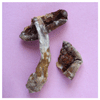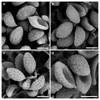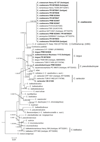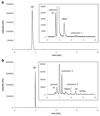Resurrection of Cortinarius coalescens: taxonomy, chemistry, and ecology
- PMID: 30210270
- PMCID: PMC6130708
- DOI: 10.1007/s11557-017-1331-z
Resurrection of Cortinarius coalescens: taxonomy, chemistry, and ecology
Abstract
Cortinarius coalescens Kärcher & Seibt is a rare European species of the subgenus Phlegmacium, section Phlegmacioides, neglected in recent molecular studies. New primers (CortF and CortR) designed for species in the section Phlegmacioides allowed to obtain ITS rDNA sequence data from the holotype collection of C. coalescens; according to the results, this epithet has priority over C. crassorum Rob. Henry ex Rob. Henry, C. pardinus Reumaux, and C. parargutus Bidaud, Moënne-Locc. & Reumaux. Morphological and ecological observations on recent collections of C. coalescens from the Czech Republic in comparison with the co-occurring C. largus are discussed. Nomenclatural and taxonomic comments on C. tomentosus Rob. Henry, C. balteatotomentosus Rob. Henry, and C. subtomentosus Reumaux are also provided. So far, C. coalescens is known with certainty from Germany, France, and the Czech Republic, where it grows in deciduous forests on acid to neutral soils. Arsenic and its compounds were determined in C. coalescens and related species of the section Phlegmacioides: C. largus, C. pseudodaulnoyae, and C. variecolor. Total arsenic concentrations were in the range 3.6-30.2 mg kg-1 (dry matter) and arsenobetaine was the major arsenic compound.
Keywords: Arsenic; Arsenobetaine; Bioaccumulation; Cortinariaceae; Phlegmacioides clade; Soil.
Figures







References
-
- Baize D. Soil science analyses: a guide to current use. John Wiley & Sons Ltd; Chichester: 1993.
-
- Bidaud A, Bellanger JM. À propos de Cortinarius daulnoyae Quél. J JEC. 2016;18:13–23.
-
- Bidaud A, Moënne-Loccoz P, Reumaux P, Henry R. Atlas des Cortinaires VII. Fédération Mycologique Dauphiné-Savoie; Annecy: 1995.
-
- Bidaud A, Moënne-Loccoz P, Reumaux P, Henry R. Atlas des Cortinaires IX. Fédération Mycologique Dauphiné-Savoie; Annecy: 1999.
Grants and funding
LinkOut - more resources
Full Text Sources
Other Literature Sources
Molecular Biology Databases
